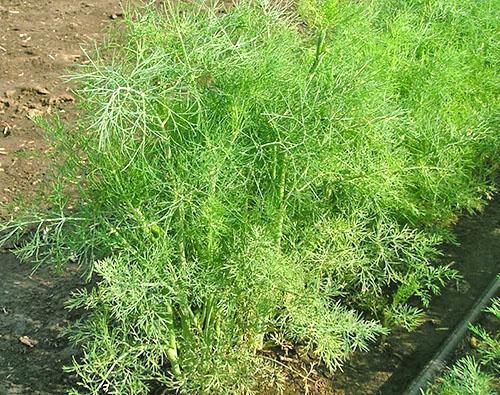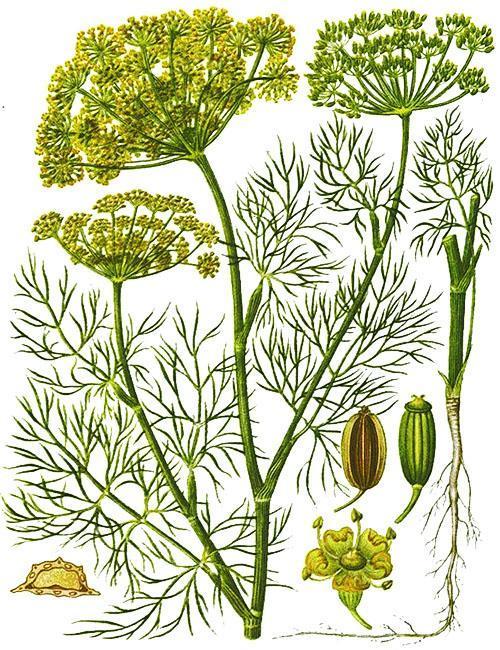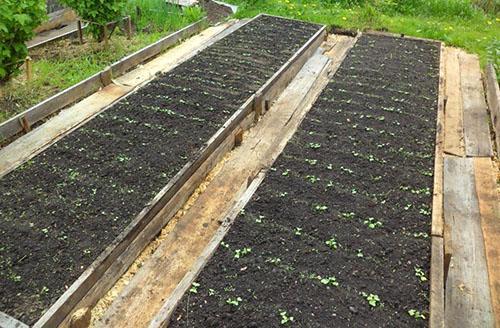Planting and caring for dill in the open field
 Dill can be found in any garden. Spicy fragrant grass with a lot of useful properties can grow by self-sowing on the plantation, like a weed. But most often the gardener chooses varieties and hybrids, determines the place of sowing the culture. Planting and caring for dill in the open field has features. To get a lot of fragrant greenery, you should know the plant's agricultural technology.
Dill can be found in any garden. Spicy fragrant grass with a lot of useful properties can grow by self-sowing on the plantation, like a weed. But most often the gardener chooses varieties and hybrids, determines the place of sowing the culture. Planting and caring for dill in the open field has features. To get a lot of fragrant greenery, you should know the plant's agricultural technology.
How to grow dill outdoors

So, for dill you need:
- neutral light soil;
- sunny or slightly shaded sowing place;
- deep arable layer;
- moderate watering without stagnant water;
- timely balanced feeding.
At the same time, dill develops poorly and turns red on acidic soil and turns yellow on alkaline soil. For the health of dill, it is necessary to have a good humus layer of soil. Top dressing with organic and mineral fertilizers when growing dill in the open field, they will help to get a lot of vitamin greens.
Sowing dates and soil preparation
 Sowing dill seeds for greens and seeds can be winter and early spring. To get greens and umbrellas for salting, you can sow seeds throughout the season until mid-August. In the future, a cold-resistant culture, falling under short frosts, does not die, but loses the decorativeness of the foliage, it becomes red and dry.
Sowing dill seeds for greens and seeds can be winter and early spring. To get greens and umbrellas for salting, you can sow seeds throughout the season until mid-August. In the future, a cold-resistant culture, falling under short frosts, does not die, but loses the decorativeness of the foliage, it becomes red and dry.
Do not place dill on the soil after liming and adding dolomite flour. When sowing seeds, it is impossible to sprinkle the bed with ash against pests in the future. The acidic swampy soil is detrimental to dill.
The dill soil is prepared in a place open to the sun with deep digging. At the same time, a bucket of humus or compost, two tablespoons should be added to each square of the earth superphosphate and a spoonful of potassium sulfate. Ash for sowing is not applied. With a high standing groundwater, the bed is raised higher. Any plant other than celery can be the predecessors of dill.
Seeds germinate at a soil temperature of 5-7 degrees, while withstanding a short drop in temperature. Preliminary preparation of seeds for fast germination consists in the destruction of the casing layer. How to plant dill seeds outdoors depends on the season. So, podzimny sowing is done with seeds without preliminary processing. Do not accelerate seedlings when sowing early. In this case, the biological calendar of the plant, laid down by nature, suggests the optimal time for germination.
If sowing is carried out later, when return frosts are impossible, seedlings can be obtained earlier. For this, the seeds are pre-germinated for 4 days. In a warm place in a linen cloth, the seeds will sprout, and seedlings will appear in a week. You can pre-hold the seed in growth stimulants, ash extraction. When soaking the seeds, water is changed 2 times a day.
If you grow dill seedlings, then the development of plants will accelerate. Seedlings are planted in the evening and shaded for several days. The plant survival rate is good.
 Sowing must be carried out to a depth of 2 cm along the grooves previously spilled with a hot solution of potassium permanganate. The distance between the seeds is 5 cm, between the grooves is 20.You can seed dill in open ground as a compacting crop among other vegetables, leaving enough room for it to grow. To obtain greens throughout the season, dill is sown in two weeks. Another way would be to use varieties of different ripening periods, sowing bush bush hybrids.
Sowing must be carried out to a depth of 2 cm along the grooves previously spilled with a hot solution of potassium permanganate. The distance between the seeds is 5 cm, between the grooves is 20.You can seed dill in open ground as a compacting crop among other vegetables, leaving enough room for it to grow. To obtain greens throughout the season, dill is sown in two weeks. Another way would be to use varieties of different ripening periods, sowing bush bush hybrids.
Growing dill in the open field
 In order for dill to develop well, he needs nitrogen fertilizers... But spicy greens accumulate nitrate compounds, which makes them less healthy. Therefore, it will be best to feed the plant with nettle infusion fermented for five days. This is a good nitrogen supplement and aphids do not tolerate it. You can immediately protect the plant and feed it. You cannot use insecticides on dill.
In order for dill to develop well, he needs nitrogen fertilizers... But spicy greens accumulate nitrate compounds, which makes them less healthy. Therefore, it will be best to feed the plant with nettle infusion fermented for five days. This is a good nitrogen supplement and aphids do not tolerate it. You can immediately protect the plant and feed it. You cannot use insecticides on dill.
To scare away and remove aphid colonies on a vegetable garden, you can use spraying with a solution of an alcoholic liquid. If you use 2 tablespoons of Troy per 10 liters of water, spraying will drive the pest away. Alcohol should only be unrefined ethyl, with a fusel odor or perfume. Aphids will fall, it needs to be covered with earth.
Another way to prevent the main pest of dill greens is to sow several bushes of thyme, the smell of which will scare away aphids. In addition, you can use liquid fertilizing with organic fertilizers, nitrate. But it should be borne in mind that fungal diseases, rot, develop on damp, nitrogen-saturated soils. It is necessary to maintain a balance, do not overfeed, do not flood the plant, after each watering, loosen the soil, delivering oxygen to the lower layers.
How to grow dill outdoors if there are changes in the color of the openwork foliage. If the twigs become yellow, you need to feed the plant with saltpeter, watering at the root. Red lower leaves signal phosphorus deficiency. The bush wilted, despite watering, you need to remove the diseased plant and determine the cause. This is often due to root rot with improper care. It is no longer possible to save such a plant; measures must be taken to prevent the infection from spreading to neighboring bushes.
Useful properties of dill
 You can use greens as they grow. The herb acquires the greatest aroma during the formation of the inflorescence, before its disclosure. At this time, fragrant greens are harvested for winter use. The substances contained in this spicy greens have a beneficial effect on the body in small quantities.
You can use greens as they grow. The herb acquires the greatest aroma during the formation of the inflorescence, before its disclosure. At this time, fragrant greens are harvested for winter use. The substances contained in this spicy greens have a beneficial effect on the body in small quantities.
In addition to cooking, where dill is indispensable, it is used for medicinal purposes:
- reduces blood pressure in hypertensive patients;
- improves the digestive tract;
- has an analgesic effect;
- improves the functioning of the genitourinary system;
- improves lactation.
Dill oil and seeds are used with special properties in use as medicines. However, you can not abuse fresh herbs, you can lead your body to a reduced tone and drowsiness.